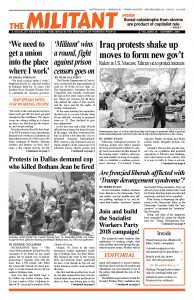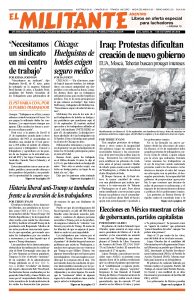As the November midterm elections loom, liberals in the Democratic Party and media, and the middle-class left, are grabbing anything to try and advance their frenetic “resistance” against the Donald Trump presidency. They are driven by fear of the workers who voted for Trump, who they claim are racist and reactionary and have to be controlled.
Their frenzy is deepening the splintering in the Democratic Party, as the Democratic Socialists battle the “progressives” to represent the “resistance” this November.
Trump and some of his supporters have responded by saying the liberals have the “Trump Derangement Syndrome.” This description has ruffled the feathers of prominent New York Times columnists.
In his Sept. 16 column titled, “Not Deranged. Determined!” Times scribe Charles Blow argues the president was elected by “white racial anxiety, reaction to the first black president, unease about the possibility of the first female president, voter suppression and voter apathy, and an attack on our elections by the Russians.”
He says that because Trump is president “we live a life with nerves frayed and bodies pushed to the edge of our seats.” He adds, “This constant state of chaos and anxiety has been exhausting and nearly unbearable.” And the workers are a problem, because “there are people who support him without hesitation and without question.” Blow does sound a little unhinged.
The response of the liberals has been an all-out effort to paint the administration as beyond the pale.
Congresswoman Maxine Waters called for resisters to seek out administration members and harass them. Incitement like this led to its ultimate outcome last year when Bernie Sanders supporter James T. Hodgkinson went to a congressional softball practice and opened fire on Republican legislators, attempting to assassinate as many as possible. He shot and nearly killed Rep. Steve Scalise before he was stopped.
Other “resisters” propose restrictions on political rights and the right to vote of the workers Hillary Clinton described as “deplorables” in her losing 2016 campaign. The latest call comes from another Times columnist, David Leonhardt, who demands term limits on Supreme Court justices. He denounces the “randomness of how long justices live.”
His proposal would turn the Supreme Court even more into another legislative body, a constant dream of the liberals, with a membership changing to push each administration’s political agenda. He says this would require a change in the Constitution, but to liberals that document is outdated.
Calling Donald Trump a fascist does a great disservice to workers seeking to understand class society and defend their interests. The Times reviewed How Fascism Works by Jason Stanley, who says fascism is “ultranationalism of some variety (ethnic, religious, cultural) with the nation represented in the person of an authoritarian leader who speaks on its behalf.”
He argues Trump fits the bill. “And 20 months into Trump’s presidency, the evidence is mounting that he’s right,” Times reviewer Peter Beinart says.
But the U.S. isn’t a fascist country today. Workers haven’t been crushed in blood after seeking to take political power. The capitalist rulers feel no need to turn power over to a Bonapartist dictator as the only way to defend their system. Workers today can and do fight to defend and expand their political rights.
It’s a canard that workers are more racist and reactionary today. Because of the mass proletarian battle for Black rights, and decades of working and living side by side with immigrant co-workers, workers today are less racist, less anti-immigrant than ever before.
Leonhardt wrote another column for the Times Sept. 16, titled “‘Trump Derangement Syndrome’ Is a Myth.” He attacks the Bernie Sanders and Democratic Socialists of America wing of the party, saying the Democrats “have not actually become radical leftists.” He believes the “leftists” are a danger to the Democrats’ chances in the elections.
Most importantly, he concludes, “The one mistake no voter should make is pretending that the two parties are just different versions of the same thing.” But that is one thing many workers correctly sense and why the Socialist Workers Party gets a hearing today.
Rulers’ ‘world order’ decaying
The U.S. rulers face a historic turning point as the “world order” they imposed after emerging the victor in the second imperialist world slaughter in the 1940s is coming apart. The Trump White House recognizes this and has ceased operating on the false premise — relied on by the last several Democratic and Republican administration alike — that the U.S. capitalist rulers can still impose their will anywhere they choose.
They are pushing against institutions and alliances from the past, seeking bilateral agreements to blunt war threats and achieve some stability for U.S. capital.
In an article in the Washington Post Aug. 30, headlined “The Trump Presidency Marks the End of the American Century,” Mitchell Lerner laments “the potential demise of the international alliance system that lies at the heart of the modern American success story.” Lerner claims bodies like NATO, the U.N. and International Court ensure “peace and prosperity.” But the crisis of capitalism, and growing antagonism among former allies, is ripping this apart.
Moves by the White House — from Korea to Afghanistan and the Middle East — are aimed at advancing the interests of the ruling rich. But they have unintended results that are good for working people, opening space for political discussion, debate and action by workers to defend their rights and class interests.
“The Socialist Workers Party starts from the fact that the U.S. is divided into opposing classes, as are the competing capitalist powers. Workers advance our interests when we organize independently of the bosses, their parties and their state,” Róger Calero, SWP candidate for governor in New York, said Sept. 19. “This is the road to increasing workers’ self-confidence and class consciousness. It advances international working-class solidarity. It’s the course to build a movement that can take political power.”

